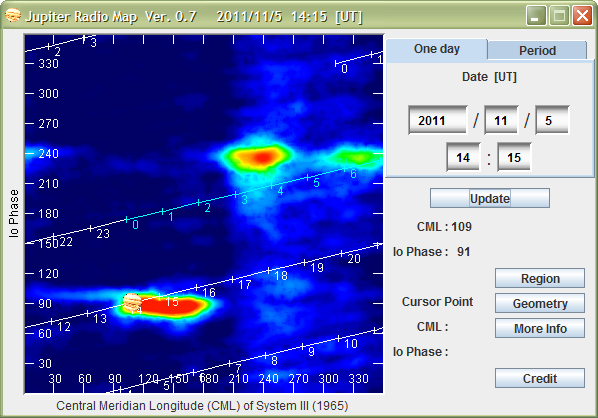Jupiter Io-B on 5 November 2011
This was an early-morning pass. We used two Icom R-75 HF Receivers, one tuned to 19.430 MHz (LSB), corresponding to the Red trace in the charts below, and the other tuned to 20.039 MHz (LSB), corresponding to the Green trace. The receivers were connected to the antenna through a multicoupler. The antenna was an 8-element log periodic antenna pointed about 258 degrees true (no tracking was used). The ambient RF noise level in this direction is fairly high (over 300k K). The Radio SkyPipe chart was calibrated the evening before this session.
 The predicted activity included an Io-B enhanced storm
from 1330 to 1500. We detected some brief activity at 1346 and almost continuous
activity with both
receivers from 1405 through 1437.
The predicted activity included an Io-B enhanced storm
from 1330 to 1500. We detected some brief activity at 1346 and almost continuous
activity with both
receivers from 1405 through 1437.
The Jupiter Radio Map is for reference and shows the orientation of the Io-B enhanced source at the observation time. We observed mostly S-bursts that shifted from receiver to receiver during the bursting periods. Links to stereo sound files of the bursts are provided below the charts. All times and dates are UTC.
At the time of the charts Jupiter was at azimuth/elevation of approximately 267 degrees true and 15 degrees above the horizon. The first chart shows the overall period including a strong RFI burst at about 1417. Note that some bursts exceeded 1.8 million K.

Click here for a short sound recording of the above S-burst
Click here for a stereo sound recording of the above bursts
Click here for a stereo sound recording of the above bursts
Click here for a stereo sound recording of the above bursts
Click here for a stereo sound recording of the above bursts. The random clicks heard near the beginning are RFI.





